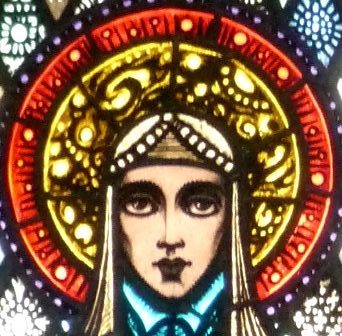St. Brigid - Harry Clarke's Stained-Glass Window


By the 650’s there was a widespread memory in Ireland of Brigid (died c. 525). She was an Abbess who according to tradition had a reputation for holiness. St. Brigid established a large religious foundation in Kildare, one of Ireland’s oldest monasteries. This draws attention to the role of women in the early Christian in Ireland.
Here at St. Mary’s Church, in Ballinrobe, County Mayo one of Harry Clarkes’s final works prior to his death was the large three-light window located at the organ gallery, representing three of the patron saints of Ireland; St Brigid is represented in one of the panels; the others being St. Patrick and St. Colmcille.
Description of St. Brigid’s representation
This very large panel shows St. Brigid as a nun in an elaborately trimmed and tasselled veil elegantly falling in pleats over her shoulders; she wears a coif headpiece, which includes a decorated cap and a turquoise wimple or guimpe with a long tassel to the front.
Her habit coloured brown is worn over a longer undergarment with an embroidered trim at its full-length hem. These garments were often loose and pleated from the neckline and can have two sets of sleeves, the larger of which can be worn folded up for work or folded down for ceremonial occasions, but in this case, it appears to be her cloak that is covering her white sleeves with a ruffled trim.
St. Brigid’s scapular is a deep turquoise colour with an overlaid intricate Celtic pattern in black. Her stole is turquoise with a long fringe. Over these garments is a purple cloak, heavily decorated on the inside hemline.
We get a tiny glimpse of Clarke’s awareness of Ireland’s heritage with the elaborate silken pointed-toe, embellished elegant tapering, green pointed slippers, which may be inspired by the Shrine of St. Brigid at the National Museum of Ireland.
Symbol
She holds a white trimmed cross in her left hand and a miniature representation of the monastery she founded in her right.
Emblem
St. Brigid’s overhead emblem is five green oak leaves and acorns represent a ‘Cill’ meaning cell or church. In Irish ‘An Daire’ means is a type of oak tree, so Kildare means “Church of the Oak” where she founded her church.
Spring/Imbolc
In Ireland’s ancient past, the 1st of February was the day on which the festival of Imbolc was held. According to folklore the year was split into four quarters or ‘Quarter Days which represented the four seasons; summer (May Day/Bealtaine), autumn (Lammas/Lúnasa), winter (Halloween/Samhain); these sections were equidistant from a solstice or an equinox. Imbolc celebrated the birth of lambs with the coming of spring and meant ‘within the womb’. It also appeared in early literature as Oímelc meaning ‘lactation’ bringing a sense fertility, birth, and renewal. Centuries later it had been altered and adopted to celebrate Lá Fhéile Bridgide, the feast of St Brigid.
Customs associated with St. Brigid
Customs associated with St. Brigid vary throughout the country but the remaining one around Ballinrobe is the making of St. Brigid crosses by many in the community, especially the children of the local national schools. Rushes are picked and woven by hand into the traditional four-armed cross associated with Brigid. These crosses are possibly Pre-Christian in origin with some three armed and elaborate lozenge types associated with other parts of County Mayo.
This first day of Spring February 1st, St. Brigid’s Day, celebrates the coming of spring which brings the gifts of renewal and growth for all.
In nature soil awaits tilling resulting in propagation, lambs have yet to be born, the daffodils will bloom shortly, leaves will soon dress our trees and winter, hopefully, will be left behind resulting in hope for a successful and healthy year ahead for all.
Further reading:
Fahey, Denis, An Irishman’s Diary, Irish Times, January, 27 January 2015 p 17
O’Hanlon,John, Lives of the Irish Saints, Duffy & Sons, London, Vol ll & lll
Staunton, Averil, Harry Clarke’s Liquid Light, BAHS, Ballinrobe, 2014, p 39

No Comments
Add a comment about this page